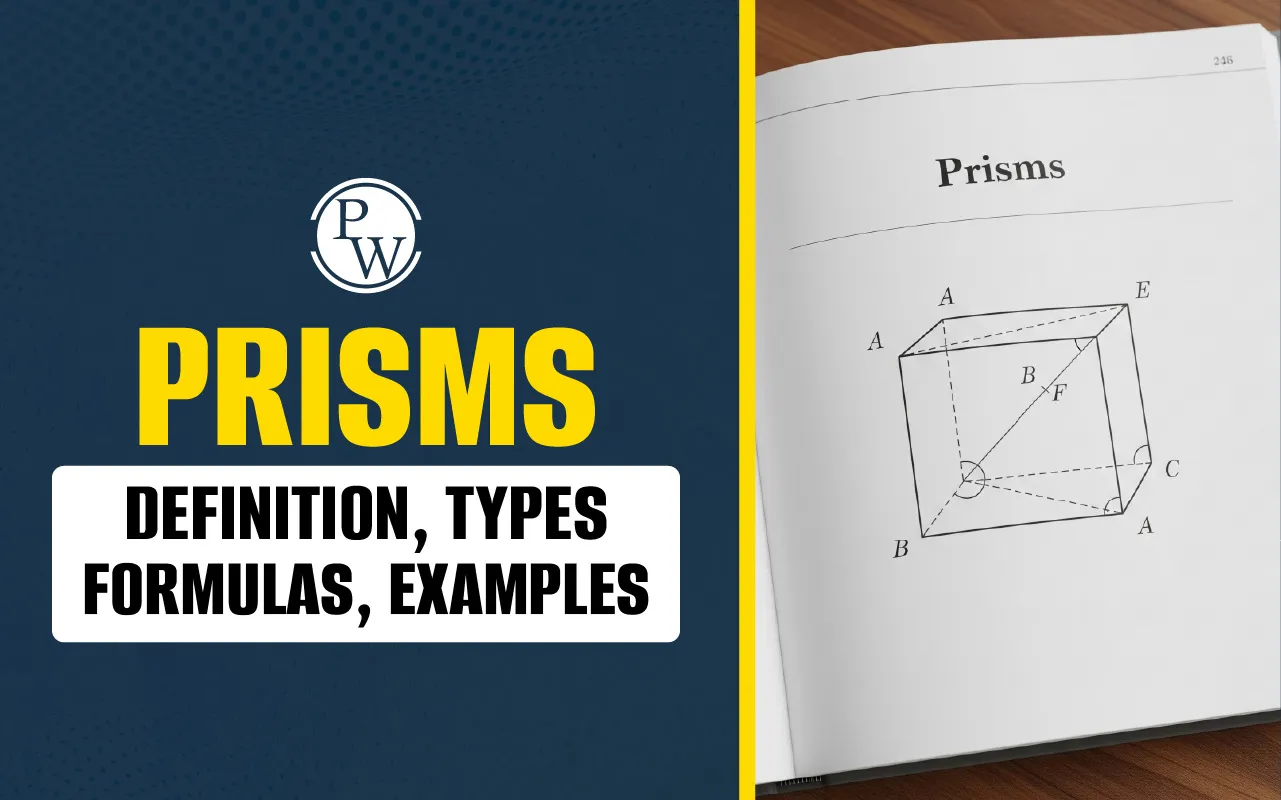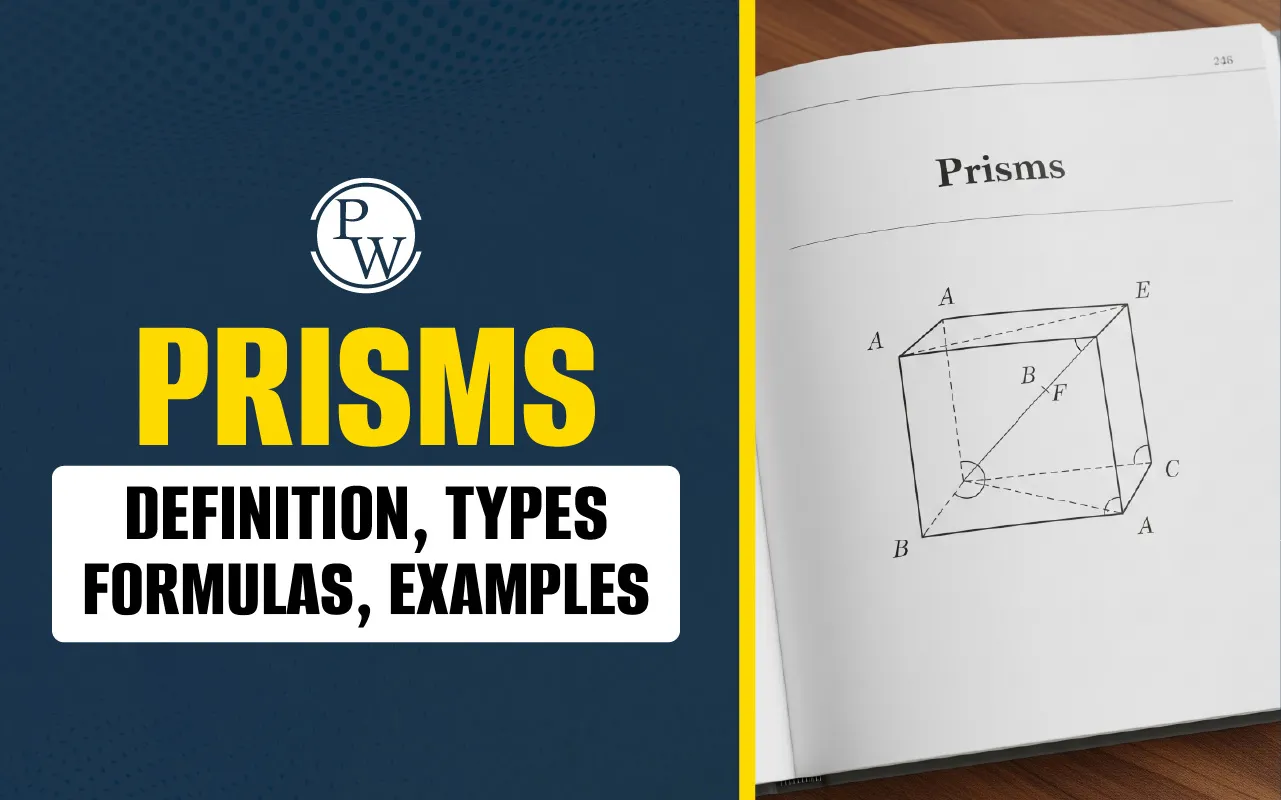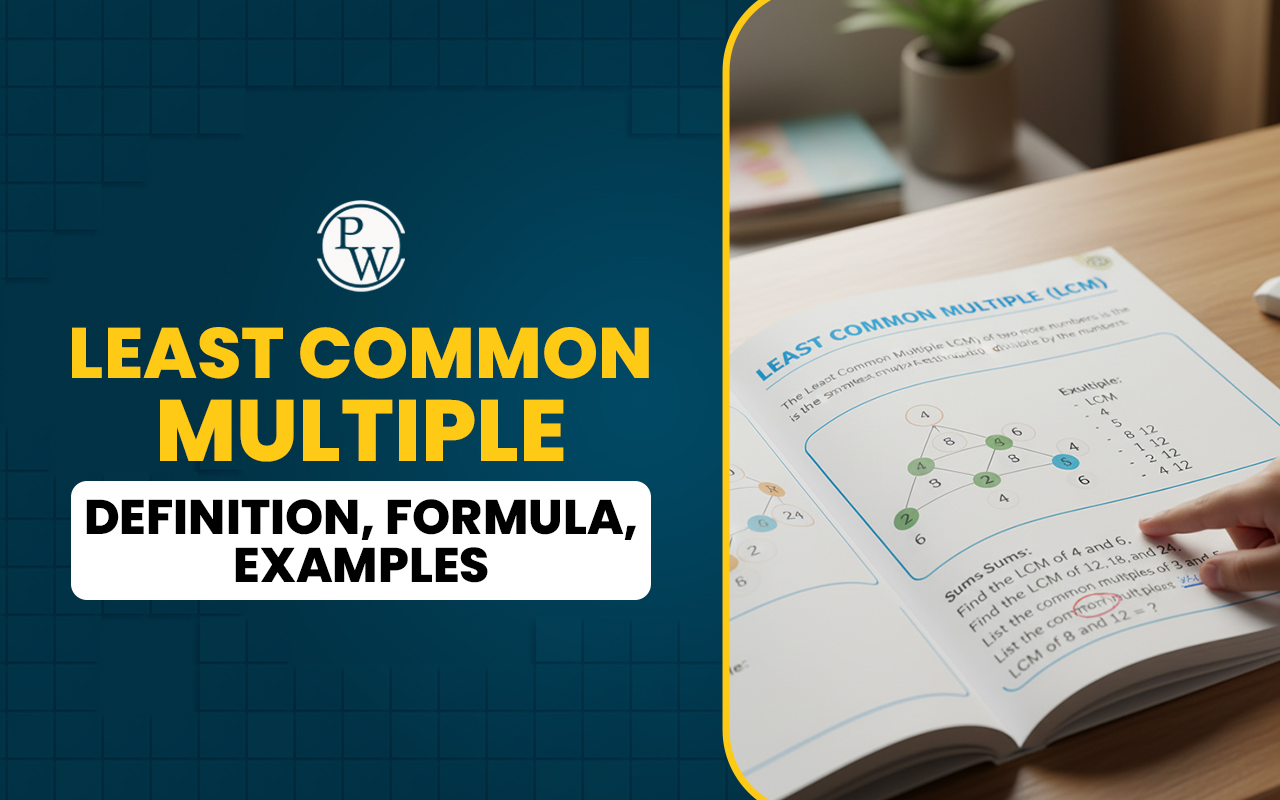

Prism is a three-dimensional shape that has the same faces on both ends. These faces are called bases, and they can be of any polygon shape. The other sides of a prism are flat surfaces, usually rectangles or parallelograms. Because of this special structure, prisms are easy to identify in geometry.
In our daily life, we can see many examples of prisms around us. They are found in buildings, containers, and even in optical devices like lenses. Their simple yet useful prism shape makes them common in construction, design, and architecture. Keep reading to learn more about the definition of prism, along with examples and types.
Read more: Unit Circle
Definition of Prism
As per the definition of prism, it is a type of solid shape that belongs to the polyhedron family. It has two congruent polygons at the base and the top. The sides of a prism are called lateral faces, and they are always flat, never curved. A special feature of a prism is that it has the same cross-section throughout its length.
Prisms are named on the basis of their cross-section. For example, a metallic nut is a hexagonal prism. A fish aquarium is a rectangular prism. In the same way, many objects around us are different types of prisms.
Types of Prism
There are different types of prisms depending on their base and alignment. Let's learn about them one by one:
Types of Prisms Based on the Type of Polygon at the Base
-
Regular Prism: If the base is a regular polygon (all sides and angles are equal), it is called a regular prism.
-
Irregular Prism: If the base is an irregular polygon (sides and angles are not equal), it is called an irregular prism.
Types of Prisms Based on the Alignment of the Bases
-
Right Prism: In this type, the two bases are directly above each other. The side faces are rectangles.
-
Oblique Prism: This prism looks tilted. The bases are not aligned, and the side faces are parallelograms.
Types of Prisms Based on the Shape of the Base
-
Triangular Prism: A prism whose two bases are triangles. The side faces are usually rectangles.
-
Square Prism: A prism whose two bases are squares. The side faces are rectangles.
-
Rectangular Prism: A prism whose two bases are rectangles. It looks like a cuboid and has rectangular side faces.
-
Pentagonal Prism: A prism whose two bases are pentagons, with five rectangular side faces.
-
Hexagonal Prism: A prism whose two bases are hexagons, with six rectangular side faces.
-
Octagonal Prism: A prism whose two bases are octagons, with eight rectangular side faces.
-
Trapezoidal Prism: A prism whose two bases are trapezoids, with the remaining faces as rectangles or parallelograms.
Read More: Introduction to Graphs
Formula for Prism
A prism has two main formulas, one for the lateral and total surface area of prism and the other for volume prism. Check the formula for prisms here:
1. Lateral Surface Area of Prism
The lateral surface area means the sum of the areas of all side faces.
Lateral Surface Area = Base Parameter × Height
2. Total Surface Area of Prism
The total surface area of prism includes the lateral area plus the area of both bases.
Total Surface Area of Prism = 2 × (Base Area) + Lateral Surface Area
Furthermore, there are seven main types of prisms, and each type has a different base shape. Because of this, the surface area of the prism formula changes depending on the shape of the base. Check the formula for prisms of different types here:
|
Formula for Prisms: Lateral and Total Surface Area of Prisms |
|||
|
Prism Shape |
Base Shape |
Lateral Surface Area Formula |
Total Surface Area Formula |
|
Triangular Prism |
Triangle |
Perimeter of Base × Height (P × h) |
2 × Base Area + (Perimeter of Base × Height) → 2Ab + Ph |
|
Square Prism |
Square |
4 × Side × Height (4a × h) |
2 × (Base Area) + 4 × Side × Height → 2a² + 4ah |
|
Rectangular Prism |
Rectangle |
2 × (l + w) × h |
2lw + 2(l + w)h |
|
Pentagonal Prism |
Pentagon |
Perimeter of Base × Height (P × h) |
2 × Base Area + (Perimeter of Base × Height) → 2Ab + Ph |
|
Hexagonal Prism |
Hexagon |
Perimeter of Base × Height (P × h) |
2 × Base Area + (Perimeter of Base × Height) → 2Ab + Ph |
|
Octagonal Prism |
Octagon |
Perimeter of Base × Height (P × h) |
2 × Base Area + (Perimeter of Base × Height) → 2Ab + Ph |
|
Trapezoidal Prism |
Trapezoid |
Perimeter of Base × Height (P × h) |
2 × Base Area + (Perimeter of Base × Height) → 2Ab + Ph |
3. Volume of Prism
The volume prism tells how much space is inside the prism. It is found by multiplying the base area by the height.
Volume (V) = Area of Base (A) × Height (H)
Volume Formula for Prisms of Different Types
The volume prism depends on the shape of its base. Here are the volume formulas for different types of prisms:
|
Volume Formula for Prisms of Different Types |
||
|
Prism Shape |
Base Shape |
Volume Prisms |
|
Triangular Prism |
Triangle |
½ × b × h × L |
|
Square Prism |
Square |
a² × h |
|
Rectangular Prism |
Rectangle |
l × w × h |
|
Pentagonal Prism |
Pentagon |
5/2 × a × b × h |
|
Hexagonal Prism |
Hexagon |
3 × a × b × h |
|
Octagonal Prism |
Octagon |
2(1 + √2) × a² × h |
|
Trapezoidal Prism |
Trapezoid |
½ × (a + b) × h × L |
Read More: Factorial of 100
Examples of Prism With Solutions
Now that you’ve learned the definition of prism, its types, and formulas, it’s time to practice with some examples of prisms to check your understanding. These examples of prisms are given with solutions to help you understand how to apply the formulas to real questions.
Example 1: Find the volume of the prism if the base area is 42 cm² and the height of the prism is 5 cm.
Solution: Volume = Base Area × Height = 42 × 5 = 210 cm³.
Example 2: A rectangular prism has a length of 9 cm, a width of 5 cm, and a height of 7 cm. Find the total surface area of prism.
Solution:
-
Base area = l × w = 9 × 5 = 45 cm²
-
Base perimeter = 2(l + w) = 2(9 + 5) = 28 cm
-
Lateral surface area = Perimeter × Height = 28 × 7 = 196 cm²
-
Total surface area = 2 × Base area + Lateral surface area
= 2 × 45 + 196 = 90 + 196 = 286 cm².
Example 3: A square prism has side a = 6 cm and height h = 12 cm. Find the lateral surface area and total surface area of prism.
Solution:
-
c (LSA) = 4 × a × h = 4 × 6 × 12 = 288 cm²
-
Total surface area (TSA) = 2 × a² + 4ah = 2 × 36 + 288 = 72 + 288 = 360 cm².
Example 4: A triangular prism has a right-triangle base with sides 3 cm, 4 cm, and 5 cm. The prism height (length) is 10 cm. Find the volume and total surface area of prism.
Solution:
-
Base area = ½ × base × height of triangle = ½ × 3 × 4 = 6 cm²
-
Perimeter of base = 3 + 4 + 5 = 12 cm
-
Lateral surface area = Perimeter × Prism height = 12 × 10 = 120 cm²
-
Total surface area = 2 × Base area + LSA = 2 × 6 + 120 = 132 cm²
-
Volume = Base area × Prism height = 6 × 10 = 60 cm³.
Make After-School Maths Learning Easier for Your Child with CuriousJr
After spending a long day at school, children feel tired and lose interest in studies. Even if you teach your child at home, subjects like Maths often need more than just extra effort; they require clear explanations, regular practice, and the right guidance. Without this, your child may struggle to understand concepts and lose marks in exams.
CuriousJr’s Online Maths Tuition Classes make your child's after-school studies effective and fun. It offers:
-
Two-Teacher Model: One teacher explains, while another answers the doubts of children during and after class.
-
Step-by-Step Learning: Concepts are explained slowly and clearly with easy examples.
-
Interactive Visuals & Fun Activities: Keeps children fresh and interested, even after school hours.
-
Homework Assistance: Helps children complete and understand schoolwork better.
-
Parent Progress Updates: Regular updates so you can track your child’s improvement.
CuriousJr’s Online Maths Tuition Classes for Class 3–9 focus on building strong basics, improving test performance, and boosting confidence. Book a demo class today to explore more.
Prisms FAQs
What is the definition of prism in maths?
How to find the total surface area of prism?
What is the formula for the volume of a prism?
Give some real-life examples of prism shape?













